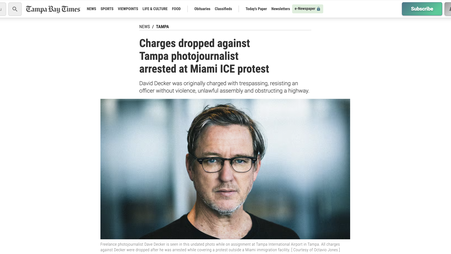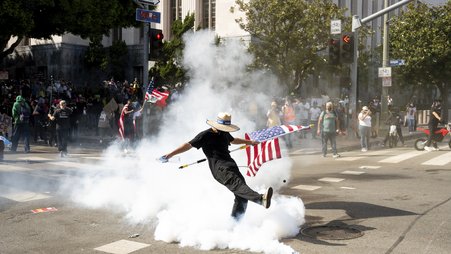
Atmore News reporter Don Fletcher and publisher Sherry Digmon were arrested after reporting on an investigation of a school board's handling of COVID funds in October. They're among at least 12 journalists arrested this year, according to our U.S. Press Freedom Tracker.
Our U.S. Press Freedom Tracker just released its annual report on arrests of journalists. At first glance, it might look like good news — the Tracker recorded 12 arrests this year, fewer than last year’s 15 and exponentially fewer than 2020’s 146.
But beneath the surface are some troubling trends, which Tracker Senior Reporter Stephanie Sugars and Freedom of the Press Foundation (FPF) Director of Advocacy Seth Stern discussed during a recent X (formerly Twitter) Spaces conversation.
As Sugars noted, in past years most arrests of journalists came with at least some pretextual legal justification — for example, that a reporter allegedly trespassed. This year, she said, we saw arrests even where “there was no such pretense available.”
These arrests, Sugars said, represent a disturbing tendency toward “criminalization of what is very standard newsgathering practice,” like asking officials for comments or publishing leaks. “Either they don’t understand this is very routine, or they’re trying to use prosecutions or other forms of legal recourse as a cudgel to prevent future reporting.”
Sugars pointed to the arrests in Alabama of Atmore News publisher Sherry Digmon and reporter Don Fletcher. They were charged under a grand jury secrecy statute for reporting about a grand jury investigation of the local school board, despite that the grand jury secrecy statute, by its own terms, is plainly inapplicable to journalists.
Then, as a term of their bail, they were censored from talking about, or reporting on, their own case or any other criminal investigations.
Sugars also discussed the case of Daily Southtown reporter Hank Sanders, who was issued three frivolous tickets for nothing more than asking public officials questions. The Chicago suburb of Calumet City dropped the citations against Sanders after it became a national laughing stock, but the charges against Digmon and Sanders remain pending.
As for the relatively low total arrest number, Sugars noted that journalist arrests strongly correlate to civil unrest. That’s what accounted for the spike in 2020, when all but nine of 146 arrests occurred during protests. “We routinely find that a protest is the most dangerous assignment for a journalist, not only because of the threat of arrest but also assault,” as well as equipment seizure by law enforcement officers, Sugars said.
She explained that a lower number of arrests more likely reflects a lower number of protests — not a lasting change in the attitudes of law enforcement.
Stern added that, although there have been some recent statements from the federal government supporting the rights of journalists to cover protests, little has been done to turn those words into practice. That’s concerning, especially heading into an election year that could see more than its share of civil unrest.
In the meantime, police departments are coming up with creative new ways to crack down on coverage of protests, like declaring entire protest areas crime scenes to exclude reporters.
Government hostility toward the press also manifested itself in ways not necessarily captured by arrest statistics. Stern highlighted the law enforcement raids of the Marion County Record in Kansas and of independent journalist Tim Burke’s home newsroom in Florida.
Newsroom raids, he explained, had been practically unheard of in recent decades because they’re illegal under the Privacy Protection Act of 1980. “They rarely happen because they’re not supposed to happen,” he said. “Two in a year is very concerning.”
Stern also discussed the restraining order obtained by an Arizona state senator, Wendy Rogers, against a journalist who had knocked on her door to investigate her residency. He noted, too, that the same Calumet City authorities who ticketed Sanders had also attempted to obtain a restraining order to bar him from city hall — all for asking officials questions.
Sugars and Stern agreed that the problem of arrests and other harassment of journalists is a national one. While incidents that garnered the most headlines this year occurred in rural Kansas and Alabama, the issue is by no means limited to small towns or red states.
Sugars observed that two arrests this year occurred in New York, which has had plenty of press freedom problems in recent years. But she singled out authorities on the opposite coast — specifically, the Los Angeles Police Department — as among the most “atrocious” offenders, for reasons ranging from uses of excessive force to “kettling” journalists for mass arrests.
Stern cautioned that, while some in large coastal cities may think their officials “are more enlightened, no, they’re not. The evidence doesn’t bear that out whatsoever.”
Both Stern and Sugars closed with calls for everyone who values the First Amendment to do their part to bring more attention to press freedom violations, regardless of whether the victims are household names or little-known freelancers. Journalists or others aware of violations should always inform the Tracker through its incident submission site.
But they shouldn’t stop there. It’s vital that journalists get over their reluctance to make themselves the story, and cover press freedom violations just like they would any other abuse of government power to infringe constitutional freedoms. Newsprint is the one thing journalists have more of than anyone else and they should use it to fight back.




